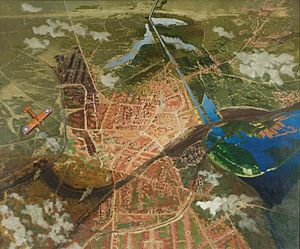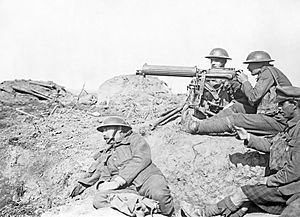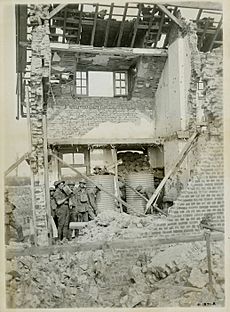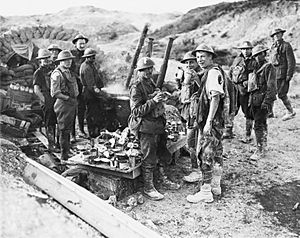Battle of Hill 70 facts for kids
Quick facts for kids Battle of Hill 70 |
|||||||
|---|---|---|---|---|---|---|---|
| Part of The Western Front of the First World War | |||||||
 Canadian soldiers in a captured German trench |
|||||||
|
|||||||
| Belligerents | |||||||
| Commanders and leaders | |||||||
| Strength | |||||||
| 4 divisions | 4 divisions | ||||||
| Casualties and losses | |||||||
| 8,677 | c. 10,000 including 1,369 taken prisoner |
||||||
The Battle of Hill 70 was an important fight during the First World War. It took place between Canadian and German armies. The battle happened near the city of Lens in France. It lasted from August 15 to August 25, 1917.
The main goal for the Canadian soldiers was to capture a place called Hill 70. They also wanted to make the German army move troops away from another big battle happening at Ypres. The Canadians planned to take the hill, then set up strong defenses. From these spots, they would use guns and artillery to stop German counter-attacks. This would cause many losses for the Germans.
The Canadians partly reached their goals. They stopped the Germans from sending local troops to Ypres. However, they couldn't draw in soldiers from other areas. Later, the Canadians tried to push into Lens itself, but this failed. Both sides agreed that the battle was successful in causing many casualties to the enemy. The fighting was very costly for both sides. Many soldiers were hurt or killed by poison gas, including a new type called Yellow Cross (mustard gas).
Why the Battle Happened
The Western Front in 1917
By May 1917, a large French attack called the Nivelle Offensive had ended badly. This led to some French soldiers refusing to fight. The British army commander, Field Marshal Sir Douglas Haig, wanted to keep fighting the Germans. He ordered his First Army to move towards Lens. They hoped to cut off the German forces in Lens.
The First Army was not at full strength. But they hoped to force the German army out of Lens by taking higher ground around the city. This included Hill 70. The British wanted to keep the Germans busy in this area. This would stop them from sending troops to other important battlefields, especially in Flanders.
On July 7, Haig ordered the Canadian army to capture Lens. This was to prevent the German army from moving soldiers north to Flanders.
Lens City and Nearby Hills
Lens was a city mostly in ruins by 1917. Years of artillery attacks had destroyed much of it. The ruins and nearby slag heaps (piles of waste from mining) made natural strong points. Several hills overlooked the city. These included Hill 70, Hill 65, and Sallaumines Hill.
Hill 70 is north of Lens. It has a flat top, giving a great view of the city and the land to the north and east. The Germans had controlled Lens and these important hills since October 1914. The British briefly captured Hill 70 in September 1915 during the Battle of Loos, but the Germans took it back.
Early Local Fights
The British First Army started planning to capture Lens in May 1917. They wanted the Canadian soldiers to attack east of Vimy Ridge. This would threaten German defenses around Sallaumines Hill. Other British troops would attack Hill 65 and Hill 70. These attacks would surround Lens on three sides. This might force the Germans to leave the city without a direct, costly attack.
On June 9, Arthur Currie became the commander of the Canadian army. He agreed that capturing Hill 70 was very important. He thought that causing many German casualties through raids and gas attacks would be a good strategy. This would make the Germans send more troops and artillery to the hill, weakening them elsewhere.
The British and Canadian forces made small advances in May and June. By June 6, the First Army had captured most of the high ground in the area, except around Lens.
Fights South of the Souchez River
To make the Germans think a big attack on Lens was coming, the British planned other attacks. On June 28, the First Army artillery began a huge bombardment. This was meant to look like a much larger attack. The infantry advanced at 7:10 p.m. They moved so fast that German counter-fire missed them. The attackers had few casualties and took 200 prisoners.
Capturing Avion
Canadian commander Currie suggested that taking Hill 65 was important for observation. He thought a raid on Avion would be better than a full capture, to avoid heavy losses. However, the British army staff wanted Avion captured to threaten Lille.
Further north, the German 56th Division was ready to pull back if pushed hard. On June 24, the British took the western slopes of Hill 65. On June 28, they captured Avion and the eastern slope of Hill 65. Rain and floods stopped them from pushing further into Lens.
Getting Ready for Battle
Canadian Army Preparations
The Canadian army used three divisions for the attack: the 1st, 2nd, and 4th Canadian Divisions. The 3rd Canadian Division was kept in reserve. Major Alan Brooke was in charge of planning the artillery. They had many guns, including 18-pounder field guns and 4.5-inch howitzers. Many of these guns were old or worn out.
The Canadians also had heavy siege howitzers. These included 9.2-inch, 8-inch, and 6-inch howitzers, plus 60-pounder guns. About a quarter of the heavy artillery was not very reliable.
German Army Preparations
The German 6th Army defended the area between Lille and Cambrai. Lens was an important railway hub. Hill 70 was held by the German 7th Division. Lens itself was defended by the 11th Reserve Division. The Germans expected a Canadian attack. They moved two more divisions, the 4th Guard Division and the 220th Division, into the area as reserves. These reserve divisions practiced reinforcing the front lines and launching counter-attacks.
The Canadian Plan
On July 7, Currie was ordered to attack objectives west of Lens. He decided to focus the main effort north of the Souchez River. The Canadian army would be responsible for the front from Avion to Hill 70. Currie believed that Hill 70 was so important that the Germans would try very hard to get it back. This would cause them many losses.
Canadian soldiers would quickly capture the hill and set up strong defensive positions. They would use many Vickers machine guns (48 per brigade) and artillery. This combined firepower would defeat German counter-attacks and cause as many casualties as possible.
The 1st and 2nd Canadian Divisions would attack a wide front. Their goal was to capture the main German defenses on the eastern side of Hill 70. The attack had three main stages:
- First, capture the German front line.
- Second, reach the crest of the hill (the "blue line").
- Third, take the German third line on the far slope (the "green line").
By July 22, the Canadian artillery was in position. They started cutting the German barbed wire. The attack was planned for July 30, but heavy rains turned the area into a swamp. This delayed the attack until mid-August. The bombardment continued, and the Canadians fired "creeping barrages" to make the Germans fire back. This helped them find German gun positions.
Artillery Power
For the attack, 204 18-pounder guns and 48 4.5-inch howitzers would fire a "creeping barrage." This was a moving wall of shells that advanced just ahead of the infantry. Another barrage would fire 200 yards further ahead. Heavy howitzers would fire even further.
The Canadians had 318 field guns and howitzers, plus 164 siege guns. They had huge amounts of ammunition: 300,000 18-pounder shells, 150,000 4.5-inch shells, and over 250,000 heavy artillery rounds. They also had very large 12-inch and 15-inch howitzers. These guns would fire high explosive, gas, and shrapnel shells at German gun positions.
Gas Attacks
By 1917, gas was delivered by shells. There were lethal gases like phosgene and harassing gases like tear gas. The Canadians used 15,000 gas shells. Before the attack, British engineers fired 3,500 gas drums from special launchers called Livens Projectors. These caused many casualties among German soldiers.
Machine Guns
The Canadian Machine Gun Corps had 128 Vickers machine guns. Armored cars with 32 more guns also helped. These machine guns would fire over the heads of the Canadian infantry. This "machine-gun barrage" would make it hard for German troops and supplies to move. Each Vickers gun had 20,000 bullets per day to fire day and night. This made it difficult for Germans to repair their defenses. Before the attack, about ten million machine-gun rounds were fired. After the hill was captured, 48 Vickers guns would be set up to defend it.
Air Support
The Royal Flying Corps (RFC) supported the Canadians. They used planes like the Sopwith 1½ Strutter for reconnaissance. These planes would observe German movements and report them by radio. They would also attack German artillery and troop groups with their machine guns. Other planes, like the B.E.2c, would fly contact patrols to see how far the Canadian infantry had advanced.
On August 9, six Nieuport 17 planes attacked German observation balloons. They shot them down, making it harder for the Germans to see. This also showed the Canadians' interest in the area. British planes also bombed railway junctions and airfields before the attack.
Deception Tactics
To trick the Germans about where and how big the attack would be, the Canadians used several tricks. From mid-July, British and Canadian units launched larger raids almost every night. They also released gas along the front. This made the Germans unsure where the real attack would come.
The bad weather delayed the main attack until mid-August. During this time, engineers fired 3,500 gas drums and 900 gas shells into Lens. The artillery also knocked out about 40 of 102 German artillery batteries. They used a new technique called "predicted fire," which made their shots much more accurate. Troops practiced the assault in reserve areas. On the left side of the attack, the 46th Division made a fake attack. They used gas, artillery, and even fake tanks and troops to fool the Germans.
The Battle Begins
August 15: The Main Attack
On the night of August 14/15, Canadian soldiers moved into their starting positions. German artillery fired, but not very heavily. The Germans had already moved reserves forward, expecting an attack. They spotted the main Canadian troop movements by 3:00 a.m.
At 4:25 a.m., the Canadian "creeping barrage" began. The infantry advanced right behind it. Some soldiers left their trenches early to avoid the German counter-barrage. At 4:26 a.m., engineers fired 400 drums of oil, creating a smoke screen. Artillery observers moved with the infantry. They sent 240 radio calls for artillery fire that day.
The creeping barrage moved forward in 100-yard steps. Vickers machine guns fired a barrage over the soldiers' heads. The Canadian infantry reached the "blue line" (their first main objective) in 20 minutes. They paused to dig in. They then advanced again, reaching the final objective (the "red line") by 6:00 a.m.
German resistance was strong. Canadians used Lewis guns to pin down German soldiers. Then, other soldiers attacked from the sides. On the southern side, a Canadian diversion worked well. The 12th Canadian Infantry Brigade took cover in deep shelters. They had fewer than 24 casualties on the first day.
As soon as they reached their goals, the four Canadian brigades started to dig in. Each brigade set up 48 Vickers machine guns. Observers used telephones and radios to connect with the artillery. The artillery then switched to firing "SOS barrages" to stop German counter-attacks.
Around 8:15 a.m., the German 4th Guard Division launched its first counter-attack. They had to cross about three-quarters of a mile of open ground. Canadian guns, machine guns, and rifles caused huge losses. Another attack at 12:45 p.m. met the same fate. German counter-attacks continued all day. The German artillery tried to support them. A counter-attack at 1:15 p.m. cut many Canadian telephone lines. But some still worked, and runners delivered messages. The Canadian artillery fired back, stopping the attack. They did the same for another German attempt at 6:00 p.m. Canadian machine gunners fired constantly. One company fired 271,000 rounds during the battle.
Air Operations During the Battle
The Sopwith 1½ Strutter planes of 43 Squadron were hit many times by ground fire. Two were shot down, and three crew members were wounded. One German plane was shot down. Other Sopwith Strutters were too damaged to fly the next day. British planes attacked German troops and transport. They also spotted large groups of German infantry preparing to counter-attack. The aircrews called in Canadian heavy artillery. They then attacked the Germans with their machine guns, which "almost wiped out" the German force. From August 15 to 17, the RFC sent 240 reports of German artillery. All were answered by Canadian counter-battery fire.
German Counter-attacks
The Canadians quickly dug in and built strong points. Within two hours of the battle starting, the Germans launched local counter-attacks. Between 7:00 a.m. and 9:00 a.m. on August 15, the Germans attacked Canadian positions four times. All were pushed back, thanks to forward artillery observers. These observers could now see some German positions. One attack led to hand-to-hand fighting.
The Germans quickly brought in seven more battalions from two divisions. Over the next three days, the Germans counter-attacked 21 times. A frontal attack on the afternoon of August 15 failed. Another German attack briefly recaptured Chicory Trench, but the Canadians took it back later that afternoon.
August 16–17: Continued Fighting
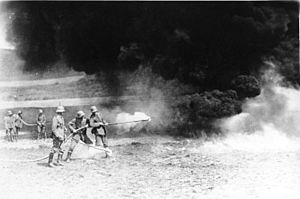
The morning of August 16 was quiet. Only small German groups tried to approach. The 2nd Canadian Infantry Brigade attacked again. They captured the rest of their final objective. This attack was costly. Hand-to-hand fighting happened at a chalk quarry, costing the Germans 100 dead and 100 wounded.
The Germans began a counter-attack at 7:15 p.m. But good observation allowed the Canadians to push them back with artillery, machine-gun, and rifle fire. To the south, the 5th Canadian Battalion pulled back slightly after many casualties and running low on ammunition.
On August 17, Canadian attempts to clear a German strongpoint failed. As expected, the Germans kept launching strong counter-attacks. German commanders realized they needed to stop Canadian artillery before their attacks could succeed. They tried to trick Canadian artillery by sending up fake flare signals. They also attacked with small groups of soldiers using cover. Some reached the Canadian defenses, leading to hand-to-hand combat.
The Germans began using poison gas heavily. They fired 15,000 to 20,000 new Yellow Cross shells, which contained sulphur mustard (mustard gas). They also used Green Cross shells. Canadian artillery positions and the front line were gassed. The 1st Canadian Division artillery had 183 casualties. Many gunners were hurt because gas fogged their masks, forcing them to remove them to aim their guns.
August 17/18: Night Attacks
On the night of August 17/18, German troops tried several times to retake the chalk quarry and Chicory Trench under cover of gas. All attacks on the quarry failed. Only one German company managed to break into Chicory Trench before being pushed back. German soldiers using flamethrowers briefly broke through the Canadian line north of the quarry on the morning of August 18, but they were also driven out.
August 19–20: Quiet Before the Storm
The front became much quieter after the last counter-attack on the chalk quarry. For the Canadian army, the next two days were mostly about strengthening their positions. The front line was moved back 300 yards. The 4th Canadian Division advanced its posts on the edge of Lens. Currie wanted to improve the position around Hill 70 even more. He ordered an attack on German positions along a 3,000-yard front.
August 21–22: Attack on Lens
This operation was planned for the morning of August 21. The attack was to start at 4:35 a.m. But the Germans began shelling Canadian positions at 4:00 a.m. Just before the Canadian attack, German units attacked the left side of the 6th Canadian Infantry Brigade. The forces met between their objectives and fought hand-to-hand. The 6th Canadian Infantry Brigade's advance was stopped, and they were forced back to their starting line. Communication broke down, making it impossible to coordinate the infantry and artillery.
On the right side, a battalion of the 10th Canadian Infantry Brigade suffered many casualties from German artillery. They were also met with heavy machine-gun fire. Only three small groups of Canadians reached their goal. The other two attacking units captured their objectives late that evening. This created a weak point in the Canadian line. On the evening of August 21, attempts to attack the German position from the sides were only partly successful. An attack on August 22 failed to happen due to misunderstandings. A reserve unit was ordered to attack the Green Crassier slag heap and the Fosse St Louis mine complex. This attack was pushed back, and most of the attackers were killed, wounded, or captured. The Germans held this area until their final retreat in 1918.
After the Battle
Casualties (Losses)
Around August 22, British intelligence estimated that the Germans had suffered 12,000 to 15,000 casualties. From August 15 to 23, the 1st Canadian Division had 3,035 casualties, with 881 killed. The 2nd Canadian Division had 2,724 casualties, with 763 killed. The 4th Canadian Division had 1,432 casualties, including 381 killed. In total, the Canadians and attached troops had 8,418 casualties. They also took 1,389 German prisoners.
Another estimate says the Canadians and attached troops suffered 9,198 casualties. More recent studies suggest the Canadians had 2,000 casualties during preparations and 9,198 from August 15 to 25. About 8,677 of these were at Hill 70. The Canadians suffered almost 4,000 casualties from August 21 to 25.
German casualties are harder to know exactly. The German 7th Division lost about 2,000 soldiers before being pulled out on August 17. The 4th Guard Division lost about 1,200 from August 15 to 21. The 220th Division also had many casualties. Experts estimate that the Germans suffered around 10,000 casualties. It was unusual for the attackers to have fewer casualties than the defenders in this war.
What Happened Next
From late August to early October, the front was relatively quiet. The Canadians focused on preparing for another attack, but it didn't happen. The Canadian army was then moved to the Ypres area in early October. They fought in the Second Battle of Passchendaele.
Soon after the battle, German commander Otto von Below was moved to the Italian front. There, he led a very successful attack at the Battle of Caporetto in October 1917. Ferdinand von Quast took over command of the German 6th Army until the end of the war.
Victoria Cross Heroes
Six Victoria Crosses were awarded to Canadian soldiers for their bravery during the Battle of Hill 70. The Victoria Cross is the highest military award for courage in British and Commonwealth forces.
- Private Harry Brown, 10th (Canadian) Battalion
- Company Sergeant-Major Robert Hanna, 29th (Vancouver) Battalion
- Sergeant Frederick Hobson, 20th (Central Ontario) Battalion
- Corporal Filip Konowal, 47th (British Columbia) Battalion (the only Ukrainian to ever receive the Victoria Cross)
- Acting Major Okill Learmonth, 2nd (Eastern Ontario) Battalion
- Private Michael O'Rourke, 7th (British Columbia) Battalion


